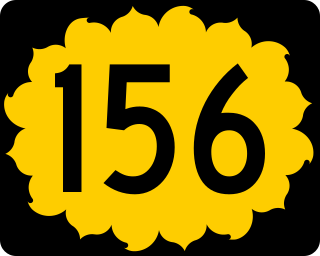
K-156 is a 175.663-mile-long (282.702 km) west–east state highway in the U.S. state of Kansas. K-156's western terminus is at U.S. Route 50 Business and US-83 Bus. in Garden City and the eastern terminus is at Interstate 70 (I-70) and U.S. Route 40 (US-40) northeast of Ellsworth. Along the way, it intersects several major highways including US-50, US-83 and US-400 in Garden City; US-283 in Jetmore; and US-183 near Rozel, and it overlaps its implied parent, US-56, from Larned to east of Great Bend.
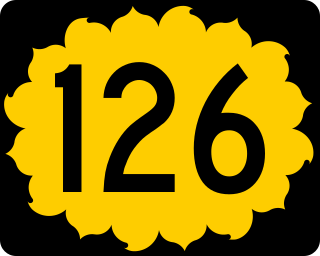
K-126 is a 26.918-mile-long (43.320 km) mostly east–west state highway located entirely within Crawford County in southeastern Kansas. Its western terminus is at U.S. Route 400 (US-400) just south of McCune, and its eastern terminus is the Missouri state line where it continues as Route 126. Along the way the highway passes through the city of McCune and also the city of Pittsburg, where it intersects US-69 and US-160.

K-4 is the longest designated state highway in Kansas, at 369.079 miles (593.975 km). It begins north of Scott City at U.S. Route 83 (US-83) and travels eastward to US-59 near Nortonville in northeast Kansas. A segment of the highway in Saline County overlaps Interstate 135 (I-135) and US-81, and a section in Topeka runs concurrent with I-70. It also intersects several other major highways, including US-283 in Ransom, US-183 in La Crosse, US-281 in Hoisington, US-77 in Herington, I-470 and US-75 in Topeka, and US-24 northeast of Topeka.
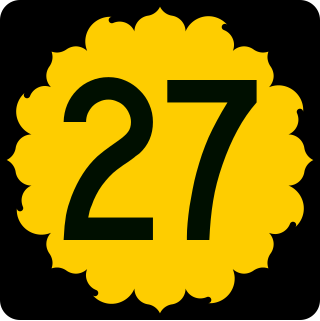
K-27 is an approximately 226-mile-long (364 km) north–south state highway that parallels Kansas' western border with Colorado. It is the westernmost north–south state highway in the state. It begins at U.S. Route 56 (US-56) in Elkhart near the Oklahoma state line and travels through the seven counties that border Colorado until reaching its northern terminus north of St. Francis, where it ends at the Nebraska state line. Along the way, it intersects several major highways, including US-160 in Johnson City, US-50 and US-400 in Syracuse, US-40 in Sharon Springs, Interstate 70 (I-70) and US-24 in Goodland, and US-36 in Wheeler. The section from US-40 north to Nebraska, is designated as the Land and Sky Scenic Byway. K-27 changes time zones twice, during its trek through Kansas, the only highway in the state to do so.

K-2 is a 61.516-mile-long (99.000 km) state highway in the south-central portion of the U.S. state of Kansas. Its southern terminus is at an intersection with U.S. Route 281 (US-281) east of Hardtner and its northern terminus is at an intersection with K-42 west of the town of Viola. Along the way K-2 passes through the cities of Kiowa, Hazelton, Anthony and Harper. Between the latter two, it has an overlap with US-160.

K-148 is an 86.665-mile-long (139.474 km) state highway in the U.S. state of Kansas. K-148's western terminus is at K-28 north of Randall and the northern terminus is a continuation as Nebraska Highway 112 at the Nebraska state line. K-148 is signed as east–west its entire length although the last roughly 20 miles (32 km) runs north–south. Along the way K-148 intersects several major highways including U.S. Route 81 (US-81) east of Norway and US-36 south of Hanover. The highway travels through mostly rural land and small unincorporated communities, however it does pass through the cities of Agenda and Barnes.

K-14 is a 219.3-mile-long (352.9 km) north–south state highway which runs through the central part of the U.S. state of Kansas. K-14's southern terminus is at U.S. Highway 160 (US-160) and K-2 in the city of Harper, and the northern terminus is a continuation as Nebraska Highway 14 (N-14) at the Nebraska border by Superior, Nebraska. Along the way it intersects several major east–west highways in the larger cities it passes through, including US-54 and US-400 by Kingman; US-50, K-61 and K-96 by South Hutchinson; K-156 and K-140 by South Ellsworth; Interstate 70 (I-70) and US-40 north of Ellsworth; K-18 in Lincoln; US-24 and K-9 in Beloit; and US-36 east of Mankato. The northern and southern halves of the highway differ fairly significantly in terms of terrain and landscape. The southern half of K-14 travels over fairly flat terrain in the valley of the Arkansas River. Just north of the intersection with K-4 in southern Ellsworth County, K-14 passes into the Smoky Hills region, traveling over a series of broad, rolling hills, providing several scenic vistas of the surrounding countryside. The portion of the highway between Lincoln and Beloit is particularly hilly.

K-181 is a 70.2-mile-long (113.0 km) north–south state highway which runs through several counties in the north central part of the U.S. state of Kansas. K-181's southern terminus is at K-232 southeast of Lucas by Wilson Lake Dam, and the northern terminus is at U.S. Highway 36 (US-36) and US-281 south of Lebanon. Along the way the highway intersects US-24 and K-9 in Downs.
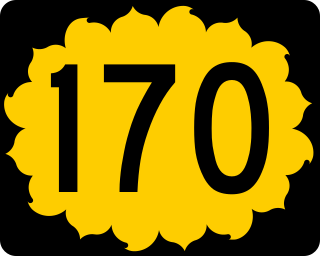
K-170 is a 21.759-mile-long (35.018 km) state highway in the U.S. State of Kansas. K-170's western terminus is at K-99 about 12 miles (19 km) north of Emporia, and the eastern terminus is at K-31 on the west side of Osage City, a mile south of the K-31 intersection with U.S. Route 56 (US-56). K-170 provides access, via county roads, to Lyons County State Fishing Lake.
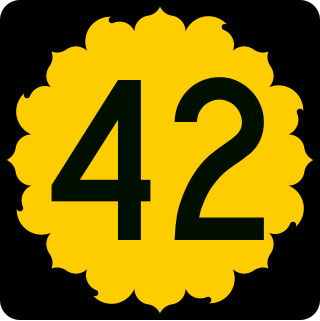
K-42 is a 75.061-mile-long (120.799 km) east–west state highway in the U.S. state of Kansas. Its western terminus is at U.S. Route 281 (US-281) in Sawyer and the eastern terminus is at Interstate 235 (I-235) in Wichita. Along the way K-42 intersects K-14, a major north–south highway, in Rago and K-2 east of Norwich. The highway is a two-lane highway for most of its length with the exception of the section within Wichita, which is a four-lane divided highway.
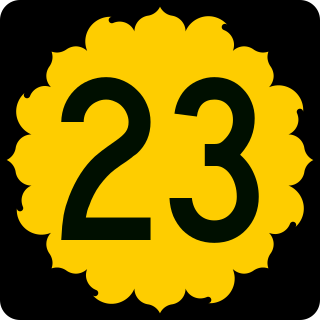
K-23 is a 199.117-mile-long (320.448 km) south–north state highway in the U.S. State of Kansas. It starts as a continuation of Oklahoma State Highway 23 (SH-23) and it runs northward to U.S. Route 83 (US-83) and K-383 near Selden. Along the way it intersects several major east–west highways, including US-54 and US-160 in Meade, US-50 and US-400 in Cimarron, US-56 near Montezuma, K-4 near Healy, and Interstate 70 (I-70) and US-40 south of Grainfield. All but about 1.5 miles (2.4 km) of K-23's alignment is maintained by the Kansas Department of Transportation. The entire section within Cimarron is maintained by the city and a section in Hoxie from Utah Street to Queen Street is maintained by the city.
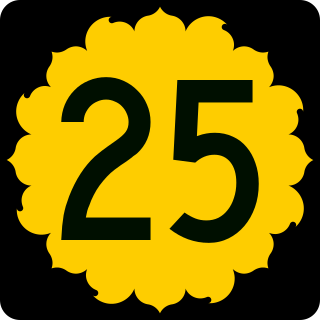
K-25 is a 238.259-mile-long (383.441 km) south–north state highway in the U.S. State of Kansas. K-25 runs from Oklahoma State Highway 136 (SH-136) at the Oklahoma State Line to Nebraska Highway 25 (N-25) at the Nebraska border, running through Leoti, Colby, and Atwood plus many more towns along the way.

K-20 is a 37.21-mile-long (59.88 km) west–east state highway in the northeastern part of the U.S. state of Kansas. It connects U.S. Route 75 (US-75) in the Kickapoo Nation Indian Reservation with K-7 southwest of Troy. Along the way, K-20 intersects several major highways, including U.S. Route 159 in Horton, and overlaps U.S. Route 73 from Horton to south of Everest. Northeast of Denton, the highway intersects K-120, which travels north to Severance and Highland. K-20 travels through mostly rural farmlands and is a two-lane highway its entire length.

K-57 is a 31.2-mile-long (50.2 km) north–south state highway in the U.S. state of Kansas. K-57's southern terminus is at K-4 in Dwight. The northern terminus is at U.S. Route 77 (US-77) north of Junction City. The highway intersects Interstate 70 (I-70) in Grandview Plaza; at the intersection, I-70 is also the route of US-40 and K-18. K-57 overlaps US-40 Business from I-70 northbound to North Washington Street in Junction City. North of Junction City, the highway passes through Milford State Park where it crosses the Milford Lake Dam. The majority of the highway is two-lanes except for the section from J Hill Road in Grandview Plaza to the junction with K-244 which is four-lanes.

K-63 is an approximately 58.8-mile-long (94.6 km) state highway in the U.S. state of Kansas. It is a north–south highway that serves small towns in the northeast part of the state. K-63's southern terminus is at U.S. Route 24 (US-24) in St. Marys and the northern terminus is a continuation as Nebraska Highway 50 (N-50) at the Nebraska border. The highway passes mostly through rural farmlands, however it does pass through the cities of Emmett, Havensville and Corning. It also passes along the edge of Seneca, where it has a short overlap with US-36.
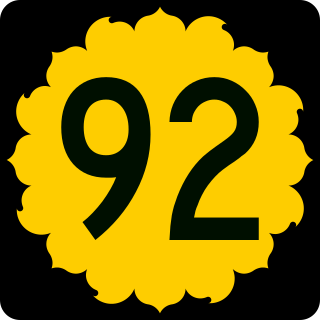
K-92 is an approximately 44-mile-long (71 km) state highway in the U.S. state of Kansas. K-92's western terminus is at K-4 south of the community of Rock Creek, and the eastern terminus is a continuation as Missouri State Route 92 at the Missouri border by the City of Leavenworth. K-92 is co-designated as U.S. Route 59 (US-59) in Oskaloosa, K-16 from Oskaloosa to McLouth, and K-7 and US-73 in Leavenworth. The majority of the route passes through rural farmland and is almost entirely a two-lane roadway, except for the overlap with K-7 and US-73 and a portion of the US-59 overlap, which are four-lane.

K-106 is an approximately 16+1⁄4-mile-long (26.2 km) state highway in the U.S. state of Kansas. It is signed as a west–east route even though the first approximately 6.5 miles (10.5 km) runs directly south to north. K-106's western terminus is at K-18 north-northwest of Salina, and the eastern terminus is a continuation as Lake Drive at Ottawa State Fishing Lake. About midway along the route, K-106 serves the city of Minneapolis and intersects U.S. Route 81 (US-81) just west of the city. South of Minneapolis, the highway passes within one mile (1.6 km) of Rock City, a group of 200 spherical boulders designated as a National Natural Landmark.
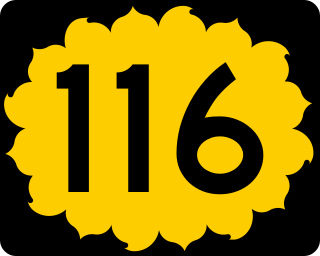
K-116 is a 26.146-mile-long (42.078 km) state highway in the northeast part of the U.S. state of Kansas. K-116's western terminus is at U.S. Route 75 (US-75) and K-16 in Holton, and the eastern terminus is at US-59 southwest of Atchison. The first 3.5 miles (5.6 km) of K-116 is co-designated with K-16. Also a brief section is co-designated with US-159 near the eastern terminus. The highway travels mostly through rural farmland and is a two-lane highway for its entire length.
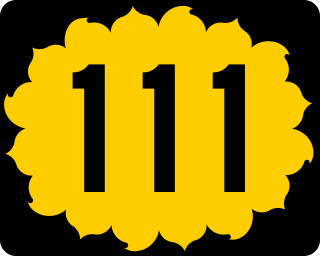
K-111 is an approximately 5.33-mile-long (8.58 km) state highway in the U.S. state of Kansas. Its southern terminus is at F Street at the Kanopolis city limits, and the northern terminus is at K-156 northeast of the city of Ellsworth. Along the way it intersects K-140 north of Kanopolis. K-111 travels through mostly flat rural farmlands south of K-140, and small rolling hills covered with grasslands north of K-140. It is a two-lane highway its entire length.
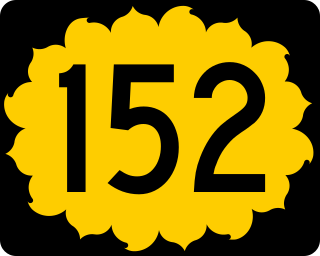
K-152 is an approximately 12.92-mile-long (20.79 km) east–west state highway located entirely within Linn County in the U.S. state of Kansas. K-152's western terminus is at K-7 east of the city of Parker and south of Cadmus, and the eastern terminus is at U.S. Route 69 (US-69) east of the city of La Cygne. The only city that the highway passes through is La Cygne, and it also passes by Prairie View High School west of La Cygne. K-152 is a two-lane road its entire length.






















